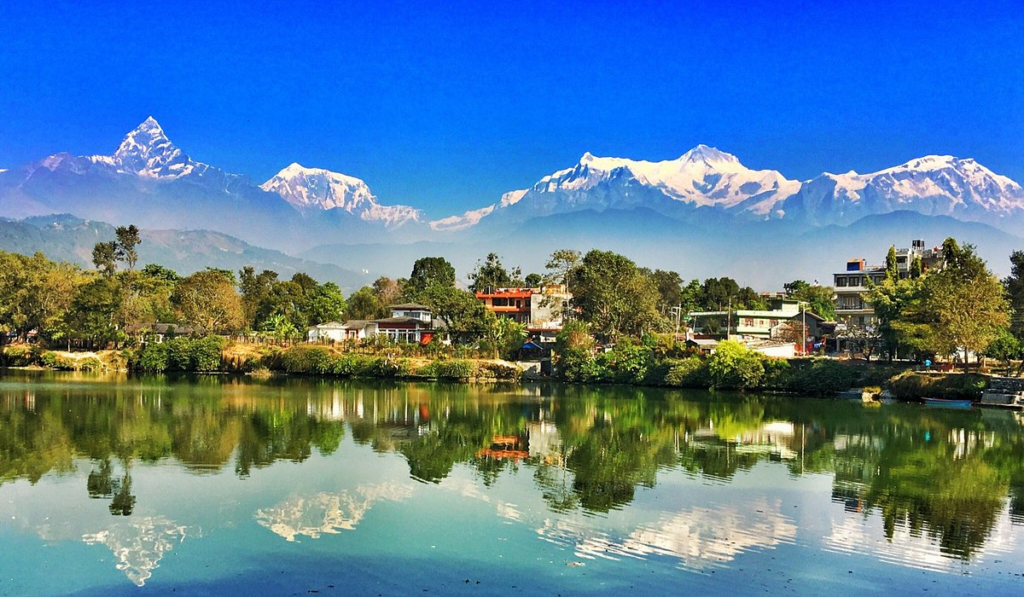Nestled in the heart of the Himalayas, Nepal is a country of unparalleled natural beauty, rich cultural heritage, and warm hospitality. With its diverse landscapes ranging from lush tropical plains to the towering peaks of the world’s highest mountains, Nepal offers a unique and unforgettable experience for travelers and adventurers. This blog explores the captivating charm of Nepal, delving into its geography, history, culture, and the many wonders that make it a must-visit destination.
Table of Contents
Geography
Nepal is a landlocked country situated in South Asia, bordered by China to the north and India to the south, east, and west. Covering an area of approximately 147,516 square kilometers, Nepal’s geography is remarkably diverse. The country can be broadly divided into three geographical regions: the Terai plains, the hilly region, and the mountainous region.
The Terai plains in the southern part of Nepal are characterized by fertile land and a subtropical climate, making it the agricultural heartland of the country. This region is home to lush jungles, wildlife reserves, and vibrant communities engaged in farming and trade.
The hilly region lies between the Terai and the Himalayas, featuring rolling hills, deep valleys, and terraced fields. This area is known for its moderate climate and scenic beauty, with charming villages and towns scattered across the landscape. The hills of Nepal are also culturally significant, housing many ancient temples, monasteries, and historical sites.
The northernmost region of Nepal is dominated by the majestic Himalayas, home to some of the highest peaks in the world, including Mount Everest (Sagarmatha) and Kanchenjunga. This mountainous region is characterized by rugged terrain, alpine forests, and glacial rivers. It is a paradise for trekkers, climbers, and adventure enthusiasts seeking to experience the awe-inspiring grandeur of the Himalayas.
States Of Nepal
Nepal is divided into seven provinces. Each province was established as part of the federal restructuring of Nepal, which came into effect with the promulgation of the Constitution of Nepal in 2015. Here is the list of the seven provinces:
| # | Province | Districts |
|---|---|---|
| 1 | Province No. 1 | Bhojpur, Dhankuta, Ilam, Jhapa, Khotang, Morang, Okhaldhunga, Panchthar, Sankhuwasabha, Solukhumbu, Sunsari, Taplejung, Terhathum, Udayapur |
| 2 | Province No. 2 | Bara, Dhanusha, Mahottari, Parsa, Rautahat, Saptari, Sarlahi, Siraha |
| 3 | Bagmati Province | Bhaktapur, Chitwan, Dhading, Dolakha, Kavrepalanchok, Kathmandu, Lalitpur, Makwanpur, Nuwakot, Ramechhap, Rasuwa, Sindhuli, Sindhupalchok |
| 4 | Gandaki Province | Baglung, Gorkha, Kaski, Lamjung, Manang, Mustang, Myagdi, Nawalpur, Parbat, Syangja, Tanahun |
| 5 | Lumbini Province | Arghakhanchi, Banke, Bardiya, Dang, Gulmi, Kapilvastu, Palpa, Pyuthan, Rolpa, Rukum (East), Rupandehi |
| 6 | Karnali Province | Dailekh, Dolpa, Humla, Jajarkot, Jumla, Kalikot, Mugu, Rukum (West), Salyan, Surkhet |
| 7 | Sudurpashchim Province | Achham, Baitadi, Bajhang, Bajura, Dadeldhura, Darchula, Doti, Kailali, Kanchanpur |
History
Nepal’s history is as rich and varied as its geography. The earliest inhabitants of Nepal were the Kirat people, who settled in the region over 2,500 years ago. Over the centuries, Nepal has seen the rise and fall of various dynasties and kingdoms, each contributing to the country’s cultural and architectural heritage.
One of the most significant periods in Nepal’s history was the reign of the Licchavi dynasty, which began around the 4th century AD. The Licchavi period is known for its advancements in art, architecture, and trade, as well as the establishment of Buddhism as a major religion. This era saw the construction of many iconic temples and stupas, some of which still stand today.
The Malla dynasty, which ruled from the 12th to the 18th century, further enriched Nepal’s cultural landscape. The Malla kings were great patrons of the arts, and their reign saw the flourishing of literature, music, dance, and architecture. The beautiful palaces, temples, and squares of the Kathmandu Valley, including those in Kathmandu, Patan, and Bhaktapur, are a testament to the Malla dynasty’s contributions.
In the late 18th century, King Prithvi Narayan Shah unified the various small kingdoms and principalities of Nepal, establishing the Shah dynasty and the modern state of Nepal. The Shah dynasty ruled Nepal for over two centuries, with the monarchy being abolished in 2008, leading to the establishment of a federal democratic republic.
Himalayas
The Himalayas in Nepal are a majestic and awe-inspiring range of mountains that stretch across the northern part of the country, forming a natural border with Tibet. This iconic mountain range is home to eight of the world’s ten highest peaks, including the legendary Mount Everest (Sagarmatha), which stands at 8,848 meters (29,029 feet) and is the highest point on Earth.
The Nepalese Himalayas offer breathtaking landscapes, ranging from lush valleys and terraced hillsides to towering snow-capped peaks. They are not only a paradise for trekkers and mountaineers but also a cultural heartland, where ancient traditions and practices are preserved among the diverse ethnic communities living in the shadow of these colossal mountains.
The region’s stunning beauty, rich biodiversity, and profound cultural significance make the Himalayas an integral part of Nepal’s identity and a magnet for adventurers and nature lovers from around the globe.
Top Ten Most Beautiful Village Of Nepal
| # | Village | Location |
|---|---|---|
| 1 | Bandipur | Tanahun District, Gandaki Province |
| 2 | Ghalegaun | Lamjung District, Gandaki Province |
| 3 | Ghandruk | Kaski District, Gandaki Province |
| 4 | Marpha | Mustang District, Gandaki Province |
| 5 | Kagbeni | Mustang District, Gandaki Province |
| 6 | Tansen | Palpa District, Lumbini Province |
| 7 | Chitlang | Makwanpur District, Bagmati Province |
| 8 | Sirubari | Syangja District, Gandaki Province |
| 9 | Ilam Bazaar | Ilam District, Province No. 1 |
| 10 | Khumbu (Namche Bazaar) | Solukhumbu District, Province No. 1 |
Culture
Nepal’s culture is a vibrant tapestry woven from various ethnicities, religions, and traditions. The country is home to over 120 ethnic groups and 123 languages, making it a melting pot of diverse cultural practices and beliefs. The major ethnic groups include the Brahmin, Chhetri, Newar, Tamang, Magar, Gurung, Tharu, and Sherpa, among others.
Religion plays a significant role in the daily lives of Nepalis, with Hinduism and Buddhism being the predominant faiths. The harmonious coexistence of these religions is evident in the numerous temples, stupas, and monasteries found throughout the country. Festivals are an integral part of Nepali culture, with Dashain, Tihar, Holi, Buddha Jayanti, and Losar being some of the most widely celebrated.
Nepalese cuisine is a delightful reflection of the country’s cultural diversity. The staple diet includes rice, lentils, and vegetables, often accompanied by a variety of spicy pickles and curries. Popular dishes such as dal bhat (lentil soup with rice), momo (dumplings), and gundruk (fermented leafy greens) are enjoyed by locals and visitors alike.
Traditional Nepali music and dance are deeply rooted in the country’s cultural heritage. Instruments like the madal, sarangi, and bansuri are commonly used in folk music, while classical dance forms like the Newari dance, Maruni dance, and Sherpa dance are performed during festivals and special occasions.
Top Ten Must-Visit Places in Nepal
1. Kathmandu

Kathmandu, the vibrant capital of Nepal, is a melting pot of history, culture, and spirituality. The city’s rich heritage is evident in its ancient temples, stupas, and palaces. Key attractions include the UNESCO World Heritage Sites of Swayambhunath (Monkey Temple), Pashupatinath Temple, Boudhanath Stupa, and the historic Durbar Squares in Kathmandu, Patan, and Bhaktapur. Visitors can explore bustling markets, indulge in traditional Nepali cuisine, and immerse themselves in the lively atmosphere of this dynamic city.
2. Pokhara

Pokhara, known as the “Gateway to the Himalayas,” is renowned for its stunning natural beauty and adventure activities. The city is situated on the shores of Phewa Lake, with breathtaking views of the Annapurna and Dhaulagiri mountain ranges. Visitors can enjoy boating on the serene lake, paragliding over the valleys, trekking in the Annapurna region, and visiting attractions like the World Peace Pagoda, Devi’s Fall, and the International Mountain Museum.
3. Chitwan National Park

Chitwan National Park, a UNESCO World Heritage Site, offers an unforgettable wildlife experience in the Terai region of Nepal. The park is home to diverse flora and fauna, including Bengal tigers, one-horned rhinoceroses, elephants, and a variety of bird species. Visitors can embark on jungle safaris, elephant rides, canoe trips, and birdwatching tours. The park’s lush landscapes and rich biodiversity make it a must-visit destination for nature enthusiasts.
4. Lumbini

Lumbini, the birthplace of Lord Buddha, is a pilgrimage site of great significance for Buddhists and spiritual seekers. This UNESCO World Heritage Site features the sacred Lumbini Garden, the Maya Devi Temple, and the Ashoka Pillar. Visitors can explore various monasteries and meditation centers built by different countries, reflecting diverse architectural styles. Lumbini offers a serene and spiritual atmosphere, ideal for reflection and meditation.
5. Everest Base Camp

Trekking to Everest Base Camp is a dream for many adventure enthusiasts and mountaineers. This iconic trek takes visitors through picturesque Sherpa villages, lush forests, and rugged mountain terrain, offering spectacular views of Mount Everest and the surrounding peaks. The journey includes stops at notable locations such as Namche Bazaar, Tengboche Monastery, and Kala Patthar. The trek provides a unique opportunity to experience the culture and hospitality of the Sherpa people while exploring the world’s highest mountain.
6. Annapurna Circuit

The Annapurna Circuit is one of the most popular trekking routes in Nepal, offering diverse landscapes, rich cultural experiences, and stunning mountain vistas. The trek takes visitors through subtropical forests, terraced fields, arid deserts, and high mountain passes. Highlights of the trek include the Thorong La Pass, Muktinath Temple, and the picturesque villages of Manang and Marpha. The Annapurna Circuit is renowned for its breathtaking scenery and the warm hospitality of the local communities.
7. Bhaktapur

Bhaktapur, also known as Bhadgaon, is a medieval city rich in history, culture, and architecture. The city’s well-preserved Durbar Square is a UNESCO World Heritage Site, featuring ancient temples, palaces, and courtyards. Notable landmarks include the 55-Window Palace, Vatsala Temple, Nyatapola Temple, and the Bhairabnath Temple. Visitors can stroll through the narrow streets, admire the intricate woodwork, and enjoy traditional Newari cuisine in this charming city.
8. Nagarkot

Nagarkot is a hill station located near Kathmandu, renowned for its panoramic views of the Himalayan mountain range. On clear days, visitors can see Mount Everest and other prominent peaks. Nagarkot is an ideal destination for those seeking tranquility and natural beauty. Visitors can enjoy hiking, mountain biking, and watching stunning sunrises and sunsets over the mountains. The hill station’s cool climate and scenic landscapes make it a perfect getaway from the hustle and bustle of the city.
9. Gosaikunda Lake

Gosaikunda Lake, situated in the Langtang National Park, is a sacred alpine lake revered by both Hindus and Buddhists. The lake is surrounded by rugged mountains and offers breathtaking views and serene surroundings. The trek to Gosaikunda takes visitors through dense forests, traditional villages, and high-altitude landscapes. The region is also known for its rich biodiversity, including rare and endangered species. Gosaikunda is a popular pilgrimage site, especially during the Janai Purnima festival.
10. Bandipur

Bandipur is a picturesque hilltop town that offers a glimpse into traditional Nepali life and culture. Known for its well-preserved Newari architecture, Bandipur boasts charming cobbled streets, beautiful temples, and traditional houses. Visitors can explore the Siddha Gufa (cave), hike to the nearby viewpoints for stunning mountain vistas, and experience the warm hospitality of the local community. Bandipur’s tranquil atmosphere and rich cultural heritage make it a delightful destination for travelers.
Tourism
Tourism is a vital industry in Nepal, attracting visitors from around the world with its stunning landscapes, rich culture, and adventurous activities. The country’s unique topography offers a wide range of experiences, from trekking in the Himalayas to exploring ancient temples and wildlife reserves.
One of the most popular trekking destinations in Nepal is the Everest Base Camp trek, which takes adventurers through picturesque villages, alpine forests, and rugged mountain trails to the base of the world’s highest peak. The Annapurna Circuit and the Langtang Valley trek are also renowned for their breathtaking scenery and cultural encounters.
For those interested in history and culture, the Kathmandu Valley is a treasure trove of ancient temples, palaces, and monuments. The three historic cities of Kathmandu, Patan, and Bhaktapur are UNESCO World Heritage Sites, each boasting intricate architecture and vibrant cultural heritage. Notable landmarks include the Swayambhunath (Monkey Temple), Pashupatinath Temple, Boudhanath Stupa, and the Durbar Squares.
Nepal is also home to several national parks and wildlife reserves, offering opportunities for wildlife enthusiasts to spot rare and endangered species. Chitwan National Park, located in the Terai region, is famous for its population of Bengal tigers, one-horned rhinoceroses, and diverse birdlife. Bardia National Park and Sagarmatha National Park are other notable wildlife destinations.
Adventure tourism is a growing sector in Nepal, with activities such as white-water rafting, paragliding, bungee jumping, and mountain biking attracting thrill-seekers. The Pokhara Valley, with its serene lakes and stunning mountain views, is a hub for adventure sports and a popular destination for relaxation and rejuvenation.
Top Eight Most Famous Food Of Nepal








Challenges
Despite its natural beauty and cultural richness, Nepal faces several challenges that impact its development and well-being. One of the most pressing issues is poverty, with a significant portion of the population living below the poverty line. Access to education, healthcare, and clean water remains limited in many rural areas, exacerbating socio-economic disparities.
Natural disasters, particularly earthquakes, pose a significant threat to Nepal. The devastating earthquake of 2015 caused widespread destruction, loss of life, and displacement of communities. Rebuilding efforts have been ongoing, but the country’s vulnerability to seismic activity remains a concern.
Environmental degradation is another critical challenge. Deforestation, pollution, and climate change are affecting Nepal’s ecosystems and biodiversity. The melting of glaciers in the Himalayas due to global warming threatens water resources and agricultural productivity, impacting the livelihoods of millions of people.
Political instability and governance issues have also hindered Nepal’s progress. The transition to a federal democratic republic has been marked by political turbulence and challenges in establishing effective governance structures. Ensuring political stability and good governance is essential for the country’s sustainable development.
Future Prospects
Despite these challenges, Nepal has significant potential for growth and development. The country’s strategic location, abundant natural resources, and rich cultural heritage offer opportunities for economic diversification and international cooperation.
Tourism, if managed sustainably, can continue to be a major driver of economic growth. Promoting eco-tourism and community-based tourism can help preserve Nepal’s natural and cultural assets while providing income and employment opportunities for local communities.
Investment in renewable energy, particularly hydropower, can harness Nepal’s abundant water resources to generate clean energy and reduce dependence on fossil fuels. Developing infrastructure and improving access to education and healthcare are crucial for enhancing the quality of life for all Nepalis.
Strengthening disaster preparedness and response mechanisms is vital for mitigating the impacts of natural disasters. Building resilient communities and infrastructure can help Nepal better cope with future challenges and ensure a safer environment for its people.
Conclusion
In conclusion, Nepal is a country of extraordinary beauty, cultural richness, and resilience. Its majestic mountains, diverse landscapes, and warm hospitality make it a unique and compelling destination. While facing significant challenges, Nepal is actively working towards a sustainable and prosperous future. By leveraging its natural resources, cultural heritage, and strategic location, Nepal can continue to grow and develop, offering a bright future for its people and an unforgettable experience for visitors.
let’s enjoy few years on earth with peace and happiness….✍🏼🙏

